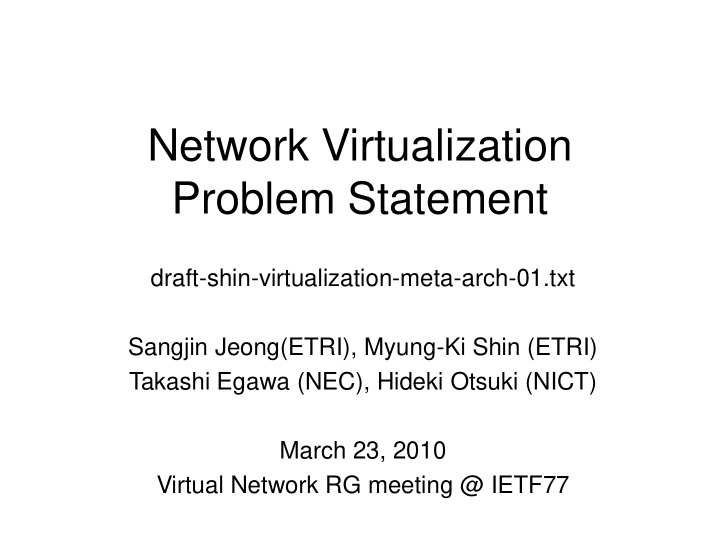



Network Virtualization Problem Statement draft-shin-virtualization-meta-arch-01.txt Sangjin Jeong(ETRI), Myung-Ki Shin (ETRI) Takashi Egawa (NEC), Hideki Otsuki (NICT) March 23, 2010 Virtual Network RG meeting @ IETF77
Objective • Discuss the problems and requirements for network virtualization in several contexts
Virtualization • The abstraction of computer resources – Hide the physical characteristics of computing resources from the way in which other systems, applications, or end users interact with those resources • Benefits of virtualization – Abstraction: To simplify the use of the underlying resource – Partitioning: To create multiple instances of the resource – Isolation: To separate the uses of the underlying resource
Network virtualization • Definition – Enables the creation of logically isolated network partitions over shared physical network infrastructures – Multiple heterogeneous virtual networks can simultaneously coexist – Support aggregation of multiple resources so as to appear as a single resource • Goal – Reduce total cost by sharing network resources while still maintaining secure separation
Motivation • Complete isolation of virtual networks over physical infrastructure – Different virtual networks may use different network technologies without interference • Easily programmable – Can experiment on any layer(s) according to user’s requirements – Define a new layering architecture without interfering the operation of other virtual networks • Reduce the total cost by increasing the utilization of resources
Problem description • Not complete isolation between multiple network services – Unexpected behavior of a service may affect other coexisting services • Security problems, performance degradation of other services • Provided network resources’ capabilities are bound to the physical capability of the resources – Hard to provide resources encompassing the physical capability of the resources • Restriction on the network scalability – User’s demands on network (ex. number of routers, switches, etc) are physically limited – Network providers are hard to offer more numbers of routers than they have
Network virtualization requirements • Creating network topologies easily and rapidly and reconfiguring them dynamically • Providing the complete performance isolation among virtual networks • Utilizing lower-layer transmission technologies provided by a transport network • Abstracting the physical network information and providing the simple interface for resource control • Regulating the upper limit of resource consumption by each virtual network in order to maintain the overall utility and performance
Network virtualization use cases • Isolation perspective – Separate network facility provider and service provider – Customized logical network based on the service providers' requirements – Provide services and applications without building its own network infrastructure – Increase utilization and reduce operational cost – Reduce the cost for building network infrastructure and utilize the flexibility • Aggregation perspective – Logically aggregate multiple resources into a single resource – Logical network element can support various functions and can easily expand its capability by aggregating multiple network elements
Next steps • Status: Problem statement document covers problems, requirements and basic use cases – Anything missing? – Solicit more comments • Investigating problems and challenges in virtual network is within the scope of RG – Adopt RG document and use it as a starting point for discussion?
Recommend
More recommend